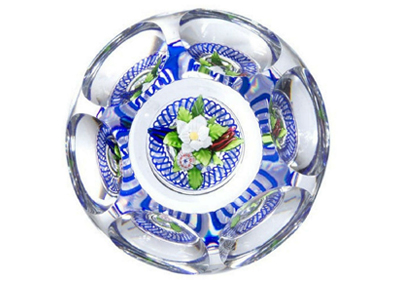
NEW YORK – Paperweights are small, heavy objects used to pin down flyaway papers. Although a stray stone could do the trick, early Victorians often favored fashionable bronze alabaster, marble or Derbyshire spar (quartz) weights. Pietro Bigaglia, a glassmaker from Murano, Venice, exhibited the first dated glass weights at the 1845 Vienna Industrial Exhibition. Their clear, non-magnifying domes often contain allover, fantastical scrambles of aventurine inclusions, white latticinio glass filigree as well as scraps of spiral, portrait and millefiori canes.
The millefiori (“thousand flowers” in Italian) technique is traditionally associated with Murano. It involves arranging multicolor glass threads in hollow glass rods, then warming, drawing and slicing them into slender cross-section discs. These are patterned on (or in) cushions in molded, molten glass bases. When complete, their designs are topped with more molten glass.

Bohemian glassmakers, who may have seen Bigaglia’s work, created decorative weights of their own. Many, perhaps utilizing end-of-the-day workshop remnants, feature large, central millefiori canes amid flowery circles. Others are patterned with tiny, close pack, allover millefiori canes, some of which feature the multi-petaled “Bohemian rose.”
Since these splendid pieces were showcased repeatedly at exhibitions, their popularity soared. In time, instead of weighting paper, they became collectibles in their own right. These small, inexpensive lovelies not only embodied beguiling glass techniques but also brightened dreary drawing rooms with shimmery, summery scenes year-round. Moreover, they made coveted gifts and souvenirs.

Most of the finest, most luxurious pieces of this era, which feature miniature designs highly magnified by their glass domes, were produced in France. Pastel-hued Clichy weights, for example, feature complex spiraled, tufted, scrambled, concentric, spaced or garlanded millefiori cane designs. Some include a tiny initialed and dated cane or depict the letter C. Others display the Clichy hallmark pink or white rose, sometimes hidden in close pack, millefiori C-patterns.
Brighter mid-19th century Baccarat lead crystal weights are also superb. Many feature millefiori canes in a complex, close pack or scattered patterns. Some include silhouette canes depicting birds or animals. Others Baccarat weights are partially lampworked or depict dominant lampwork floral, fruit, butterfly or snake motifs. This traditional glasswork technique entails heating and reheating tiny, colored rods with hand torches or flames while blowing or manipulating them into desired, three-dimensional images. When complete, their designs are covered with molten glass. Lampwork-controlled timing and temperature not only allow refinements, adjustments and spontaneous self-expression but also inspires creating complex components for larger compositions.
Saint-Louis, another famed French art glass producer, filled round, faceted and footed lead crystal weights with brightly hued millefiori canes in carpet, scramble, close pack and upright mushroom patterns. Many also bear a single deep-yellow cane or tiny animal, “dancing devil” or “dancing girl” silhouettes. Others feature bright floral designs, bouquets or lush, three-dimensional blooms filling entire domes. These were made by dipping metal crimpers into colored molten glass, then swirling them in heated, clear glass balls.

century, 3 1/8in. diameter. Realized $1,100+ buyer’s premium in 2017. Image courtesy
Jeffrey S. Evans & Associates and LiveAuctioneers
Saint-Louis also produced sulphides, intriguing weights that contain tiny porcelain cameos depicting animals, flowers, noted events or notable people. Because they were cast directly from coins, medallions or sculptures of the day, they reflect their times. Glassworkers created these popular pieces by blowing small bubbles at the ends of blowpipes, slitting them open, then inserting the cameos. After sealing and reheating the bubbles in gloryholes (kilns), they extracted their air. This encased the cameos completely.
Though rare, vintage Muranese, Bohemian and French weights remain extremely desirable, and newer ones are no less charming. From 1932 through 1979, for example, Paul Ysart, whose glassworker family immigrated from Spain to Scotland, created weights featuring imaginative millefiori work, as well as delightful depictions of ducks, dragonflies, birds and butterflies. From the 1960s through the turn of the century, reasonably priced Perthshire Paperweights, also based in Scotland, created complex millefiori and lampwork weights. Scores are exclusive limited editions, annual collection designs and commissioned one-of-a-kinds.

The Fratelli Toso glassworks, based in Murano for over a century, is famed for modern, close pack millefiori cane weights. Their handblown trumpet flower, rainbow stripe ribbon and coiled snake amid wildflower weights are also striking. Contemporary artist Paul Stankard creates exquisite, highly complex, botanically accurate, lampwork images afloat in crystal-clear, round, square and rectangular weights. Some, depicting bees hovering over daisies, for instance, faithfully replicate nature. Others feature stunning, yet far more fanciful, designs. In one, a pink tea rose, atop scattered blueberries and foliage, sits atop a mask ringed by yellowish, root-like tresses. In another, florals, scattered blueberries and an ethereal dragonfly sit atop “root people” root systems resembling humans. Each of these thumb-size baubles is a world unto itself.

to the Fratelli Toso company, 3.5in. wide x 2.75in. high. Realized $30+ buyer’s premium in 2017. Image courtesy Jasper52 and LiveAuctioneers
Whether based on traditional or cutting-edge techniques, decorative glass weights continue to evolve. Moreover, their appeal endures.
“What do President Clinton, King Farouk, Eva Peron, Colette and Truman Capote all have in common? asked the New York Times in 1998.
“They all collected glass paperweights. And why not?”



